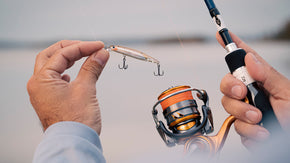Posted 18th October 2024
How to Master the Ledge: Leveraging Lever Drag Overheads for Rock Fishing Success


By Drew Dawson and Kyle Cheer
Lever Drag Overheads are the undisputed tool of choice for drifting live baits for large pelagic fish from the rocks. Let's explore why and consider how they could take your rock fishing to the next level.
Cranking Power
The ability of the Modern Lever Drag Overhead (like the Saltiga LD) to exert maximum pressure and cranking power on pelagic fish sets these reels apart. Generally, the gearing and drivetrain in a lever drag are less complex than in a spin reel. This allows for larger drive gears made of harder-wearing, stronger material. In addition, these large gears are driven through lower gear ratios to produce higher amounts of cranking power and torque.
In short, a Lever Drag allows you to use that extra torque to crank or grind on large fish and often turn fish in scenarios where it is the difference between a fish landed or a fish lost.
Drift/Line Management
Overhead lever drags can be placed into free spool, disengaging the spool from the drive gear and allowing the line to run freely. This allows anglers to control the rate and amount of line leaving the reel when drifting live baits out away from the ledge. It also allows live baits to swim freely and more lively with less resistance. Using the open-top design of the Saltiga LD, the angler can use the swell action and the rise and fall of the surge to propel live baits away from the ledge. This is done by thumbing or holding the spool as the swell rises toward the rock ledge and releasing as swell falls and the bait is sucked away from the ledge. This simply can't be replicated with a spin reel where the same level of control isn’t available.

Free Spool
The seemingly endless free spool on the Saltiga LD is unmatched in this class of reel. It forms a large part of why the reel excels at feeding out live baits away from the rock ledge and also why it allows for a higher conversion rate from bite to hook up and ultimately fish landed. Anglers can either man the rod and manage the live bait actively or 'set and forget' - both techniques can utilize free spool. If the angler is on the rod and a fish eats the live bait, the angler can utilize the free spool to feed the live bait to predatory fish. This makes for a more natural presentation and is likely to produce more full-blooded bites. The bites are also more likely to be converted into hookups, as fish will take baits are less likely to spit baits due to resistance felt through the line.
Free spool also allows for some more advanced techniques when fighting fish. Two common scenarios involve Tuna and Yellowtail Kingfish. When fighting many Tuna species, after they have expended energy on explosive opening runs, they will begin to arc along the line of the horizon back and forth. Often trying to exert more pressure on these fish will only encourage them to swim further in one direction. This is in part due to them fighting against the resistance the angler is placing through the rod and line. On larger specimens toward the end of a fight, placing more pressure and shifting the Tuna can actually also aid in getting more water over the fish's gills, essentially keeping them fresher for longer. To avoid having Tuna continue heading in a particular direction, dropping the reel into free spool and lowering the rod will release tension and pressure on the fish and often result in them turning in the opposite direction. This can save fish running around points and losing them to snags or directing Tuna into parts of the ledge where they can be landed. Kingfish don’t have the arcing tendency of Tuna but can be fooled and coaxed with free spool. If the angler is lucky enough to survive a large Kingfish's open salvo of bottom-hugging runs, free spool can be employed to 'walk the dog' away from treacherous terrain like snags and bombies. Kingfish generally will fight harder the more you pull on them, but every so often can be somewhat confused by sudden drops in line pressure.
Finally, free spool can be used on all pelagic species when trying to avoid underwater snags or above-surface obstacles. Allowing anglers to run and reposition themselves on the ledge while the line is released from the reel under a combination of free spool and thumb pressure.
Line Capacity
Overheads are king when it comes to line capacity. The Saltiga line contains a reel that will pack down enough line for anglers to tackle everything from bonito right through to Black Marlin. This huge line capacity allows anglers to tackle the largest of game fish from the rocks and leverage the benefits of comparatively high-diameter monofilament top shots, wind-ons, and leaders. The saying often goes, "You probably won't need it, but when you do, you will be lucky you had it." Land based game doesn’t allow for anglers to chase down like on boats; for this reason, line capacity is a vital consideration for land-based game anglers.
Longevity
Simple, robust, and built to last in harsh saltwater environments. It doesn’t get much harsher than the wind and water-swept ledges of the Australian coast, and for this reason, the longevity and materials a reel is built from are necessary considerations. The Saltiga LD is built from X and uses a Y design. This time-tested and bulletproof design philosophy allows these reels to stand up to the knocks, bumps, spray, and carnage that rock fishing brings.
















